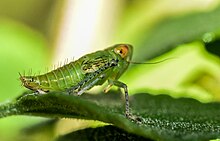Arista (insect anatomy)


In insect anatomy, the arista is a simple or variously modified apical or subapical bristle, arising from the third antennal segment. It is the evolutionary remains of antennal segments, and may sometimes show signs of segmentation. These segments are called aristameres. The arista may be bare and thin, sometime appearing no more than a simple bristle; pubescent, covered in short hairs; or plumose, covered in long hairs.[1]
The presence of an arista is a feature of the Diptera (flies) suborder Brachycera and may be especially well-developed in some species.[2] It is also present in some members of Hemiptera (true bugs), specifically in the suborder Auchenorrhyncha.[3] The arista is often covered in multiple kinds of sensilla, or sense organs, such as chemo, hygro, and thermoreceptors, which allow the insects to detect changes in their environment.[4]
References
[edit]- ^ Dessì, Giancarlo. "Notes on Entomology: Flies, Morphology and anatomy of adults: antennae". Retrieved 29 September 2020.
- ^ Foelix, R.F.; Stocker, R.F.; Steinbrecht, R.A. (1989). "Fine structure of a sensory organ in the arista of Drosophila melanogaster and some other dipterans". Cell and Tissue Research. 258 (2): 277–287. doi:10.1007/BF00239448. PMID 2510932. S2CID 5670076.
- ^ Romani, Roberto; Rossi Stacconi, Marco Valerio; Riolo, Paola; Isidoro, Nunzio (2009-11-01). "The sensory structures of the antennal flagellum in Hyalesthes obsoletus (Hemiptera: Fulgoromorpha: Cixiidae): A functional reduction?". Arthropod Structure & Development. 38 (6): 473–483. doi:10.1016/j.asd.2009.08.002. hdl:11566/51244. ISSN 1467-8039. PMID 19682602.
- ^ Altner, Helmut; Prillinger, Linde (1980-01-01), Bourne, G. H.; Danielli, J. F. (eds.), "Ultrastructure of Invertebrate Chemo-, Thermo-, and Hygroreceptors and Its Functional Significance", International Review of Cytology, vol. 67, Academic Press, pp. 69–139, retrieved 2022-08-13
- ^ "Hemiptera - Species-ID". species-id.net. Retrieved 2022-08-13.
- ^ Zhang, Chunni; Pan, Liuxing; Lu, Yeping; Dietrich, Chris; Dai, Wu (2016-05-01). "Reinvestigation of the antennal morphology of the white-backed planthopper Sogatella furcifera (Horváth) (Hemiptera: Delphacidae)". Zoologischer Anzeiger - A Journal of Comparative Zoology. 262: 20–28. doi:10.1016/j.jcz.2016.03.011. ISSN 0044-5231.
